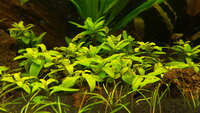dkraft12
Seedling
Hi everyone!
Wanted to ask for some help, I have a 20 gallon planted tank with a bunch of staurogyne repens that seem to be suffering. Some stats on the tank...
Lights: 2 x 105 (.1W) LED fixtures 6500K
Co2: Pressurized w/ solenoid 2-3 bps - indicator is dark green
pH: 7.8-8.0
Ferts: E.I w/ 1/4tsp traces, 1/8tsp KNO3, 1/32tsp monopotassium phosphate - all once per week after 25% water change.
substrate: inert sand.
fish: cherry barbs, neon tetras, 1 dwarf gourami, and 2 german blue rams.
The repens when i first added them grew very fast and came in nicely, this was roughly 1.5 to two months ago. For some reason lately they look droopy and are even getting holes in the leaves. I noticed that the few that are still looking very healthy may be shaded by my amazon sword (ones in the back). Could this be an issue of Co2/light balance? too much light and not enough co2 to the ones in direct light? Could it be that I have a nutrient deficiency? all of my other plants seem to be doing very well (crypts, anubias, DHG, swords), and i have no algae in the tank so I am confused as to why these guys aren't doing well.
Any and all help is appreciated!
Wanted to ask for some help, I have a 20 gallon planted tank with a bunch of staurogyne repens that seem to be suffering. Some stats on the tank...
Lights: 2 x 105 (.1W) LED fixtures 6500K
Co2: Pressurized w/ solenoid 2-3 bps - indicator is dark green
pH: 7.8-8.0
Ferts: E.I w/ 1/4tsp traces, 1/8tsp KNO3, 1/32tsp monopotassium phosphate - all once per week after 25% water change.
substrate: inert sand.
fish: cherry barbs, neon tetras, 1 dwarf gourami, and 2 german blue rams.
The repens when i first added them grew very fast and came in nicely, this was roughly 1.5 to two months ago. For some reason lately they look droopy and are even getting holes in the leaves. I noticed that the few that are still looking very healthy may be shaded by my amazon sword (ones in the back). Could this be an issue of Co2/light balance? too much light and not enough co2 to the ones in direct light? Could it be that I have a nutrient deficiency? all of my other plants seem to be doing very well (crypts, anubias, DHG, swords), and i have no algae in the tank so I am confused as to why these guys aren't doing well.
Any and all help is appreciated!



